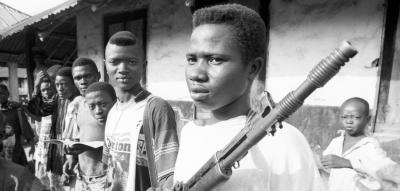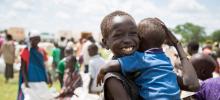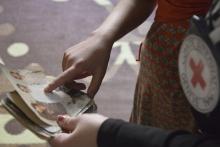Basic international humanitarian law (IHL) rules applicable to this situation:
Children affected by armed conflict are entitled to special respect and protection.
Children must not be recruited into armed forces or armed groups.
Children must not be allowed to take part in hostilities.
The case in brief
Between 1991 and 2002 Sierra Leone was ravaged by armed conflict involving government forces and non-state armed groups. Thousands of children were recruited to the ranks of the various parties. Many had never been to school.
Between May 2001 and January 2002, in the context of a large-scale demobilization, disarmament and reintegration (DDR) programme aimed at restoring peace and security in the country, the parties to the conflict released more than 6,500 children. Cooperation between the parties and the international community, including the United Nations Mission in Sierra Leone (UNAMSIL) and the United Nations Children’s Fund (UNICEF), was essential to the success of the process and sought to support the children’s return to civilian life.
IHL compliance highlights
- In May 2001, in the framework of peace negotiations and under a UN-backed DDR programme, the parties to the conflict issued a joint statement committing to releasing children who had been recruited.
- By January 2002, the parties had released 6,845 children in accordance with the programme.
- The following actions contributed to the children’s successful demobilization, made possible by cooperation between the parties to the conflict and the international community:
- public information campaigns raised awareness of the peace agreement among armed groups and the wider public, helping gain their support for the DDR process
- UNAMSIL deployed 17,500 troops to ensure adequate security
- child advocacy groups, including UNICEF, helped prepare the children for their return to communities at transitional care centres; 3,000 children benefited from UNICEF community educational programmes to support their reintegration and help prevent child recruitment in future.
Case prepared by pro bono research assistant, Adv. Romina Liberman, under the supervision of Adv. Yael Vias Gvirsman, Clinic Director, IDC University; with the contribution of Jemma Arman and Isabelle Gallino, LL.M. students at the Geneva Academy.
A. THE REVOLUTIONARY UNITED FRONT RELEASES CHILD SOLDIERS
[Source: BBC News, Sierra rebels free child soldiers, May 26 2001, available at http://news.bbc.co.uk/2/hi/africa/1352801.stm]
B. UNICEF CONFIRMS THE DEMOBILISATION OF 6,845 CHILDREN
C. UNAMSIL PROVIDING FOR SECURITY DURING DEMOBILISATION
Discussion
3. Do children have a right to education in times of non-international armed conflicts under IHL? (P II, Art 4(3)(a); CIHL, Rule 135)
4. At what age may a person be recruited into the armed forces or armed groups in a non-international armed conflict? Is it different for State armed forces and armed groups? Had Sierra Leone ratified the Optional Protocol to the Convention on the Rights of the Child at the time of the armed conflict? (P II, Art. 4(3)(c); CIHL, Rules 136-137; 1989 Convention on the Rights of the Child, Art. 38(2) Optional Protocol to the Convention on the Rights of the Child, Art. 1)
6. Considering the reactions of UN entities in the texts, how did the international community interpret the release of the children by the rebel group? How might the local population perceive this act?
7. What has been the impact of peacekeepers and UNAMSIL on the demobilisation of child soldiers in Sierra Leone? What was UNICEF’s role? In your opinion, was the coordination between the different agencies efficient?
8. (Document C) Why was the DDR process in Sierra Leone considered a “success”? What factors seem to have contributed to such positive results? In your opinion, how important is it to raise awareness among rebel groups and to publicise the content of the DDR program?






